Home> Company News> Types of cooling tower
- AddressAddress: No. 225, Huangqiao Village, Beiyuan, Tianqiao District, Jinan, Shandong, China
- Worktime9:00-18:00
- Phone(Working Time)Tel:+86 0531 85064681
- FaxFax:+ 86 0531 85064682
Types of cooling tower
2018-08-27 22:00:03The cooling tower technology started late and developed rapidly. At present, China cooling tower is close to the international leading level. A number of large-scale natural ventilation conventional towers, seawater cooling towers, exhaust gas cooling towers, “three-in-one” cooling towers, indirect air cooling towers, etc., which have been built to cover an area of over 10,000 m2, are being studied. 18000m2, cooling tower with a height of more than 200m.
With the adjustment of global energy development policies, high efficiency, environmental protection, energy conservation and emission reduction are the development trends of the power generation industry.
High-parameter large-capacity units and nuclear power plants will become the main development direction of the energy industry. With the increase in the capacity of fire and nuclear power and the construction of large indirect air-cooled units, the demand for research and design of ultra-large cooling towers will increase dramatically. Although the research on super large cooling towers with a diameter of 180m~190m and a height of more than 200m has started, it still faces many problems such as weak basic research, urgent market requirements, backward design standards and higher environmental requirements. How to design a larger, more efficient, more diverse, and safer cooling tower design is a major challenge for engineers, and it also provides a broad space for cooperation with famous cooling tower design companies.
Types of cooling tower
1 natural ventilation cooling tower;
2 mechanical ventilation cooling tower;
3 mixed ventilation cooling tower
Types of the contact mode of water and air: 1 wet cooling tower; 2 dry cooling tower; 3 dry and wet cooling tower.
Types of the flow direction of hot water and air: 1 counterflow cooling tower; 2 crossflow (straight AC) cooling tower; 3 mixed flow cooling tower
Types of the application field: 1 industrial cooling tower; 2 air conditioning cooling tower.
Types of the noise level: 1 ordinary cooling tower; 2 low noise cooling tower; 3 ultra low noise cooling tower; 4 ultra quiet cooling tower.
Divided by shape: 1 circular cooling tower: 2-square cooling tower.
Types of whether water and air are in direct contact with each other: 1 open cooling tower: 2 closed cooling tower (also called closed cooling tower, closed cooling tower).
Other types of cooling towers, such as jet cooling towers, fanless cooling towers, etc.
1. Water is in the packing in the tower, the water is from top to bottom, the air is from bottom to top, and the two flow to the opposite cooling tower.
2. The countercurrent cooling tower has good thermal performance and is divided into three cooling sections:
1 The water distributor is in the space of the top of the packing. The water temperature in this section is high, so the heat can still be transferred to the air.
2 Packing water and air heat exchange section.
3 filler to the cistern space shower section, the water is cooled in this section is called "tail effect". In northern China, the water temperature can drop by 1-2 °C. In summary, the counterflow tower is about 20% smaller than the crossflow tower under the same conditions, and the heat exchange process of the counterflow tower is more reasonable and cold.
3, the water distribution system is not easy to block, the watering filler is kept clean and not easy to aging, the moisture return is small, anti-freezing ice measures are easier. Multiple units can be combined to design, and in winter, the required water temperature and water volume can be combined into a single operation or all of the fans can be stopped. 4, construction and installation is easy to repair, low cost, commonly used in air conditioning and industrial large, medium-sized cooling circulating water.
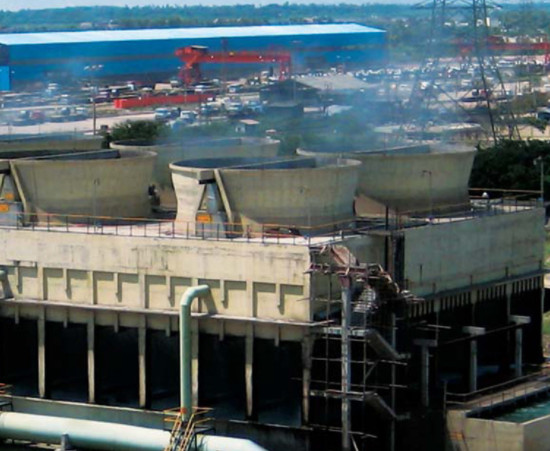 Cross flow tower
Cross flow tower
l. Water is in the packing of the tower, the water flows from top to bottom, and the air flows from the horizontal outside the tower to the tower, and the flow direction is perpendicular to a cooling tower. It is commonly used in residential areas with strict noise requirements, and is a cooling circulation tower that is used more in the air-conditioning industry. Advantages: energy saving, low water pressure, low wind resistance, low-speed motor, no dripping noise and wind noise, and easy maintenance of packing and water distribution system.
2. Multiple foundations can be constructed according to the shape of the building, and single or multiple cooling towers can be started according to the required water temperature.
3. It should be noted that the frame should have more filler volume when it is 40% more heat exchanged, the filler is easy to aging, the water distribution hole is easy to block, the anti-icing is not good, and the moisture return is large. The advantage of the crossflow tower is the disadvantage of the counterflow tower.
Unfilled cooling tower
It is installed in the upper part of the bottom of the cooling tower with a unique spray nozzle. There are two modes: spray spin without motor air supply and top tower exhaust. When the hot water is rotated through the nozzle in the nozzle, an internal swirling flow is generated to form a fine mist spray, so that the mist is present, the upward jet is flowed down, and the flow is countercurrent to the two cooling aging. Uniform atomization without hollow phenomenon, stable cooling effect, low power consumption, floating rate of 0.01%, no filler, low cost and long life, in line with GB7190.1-1997 national standard. Use range of metallurgy, food, chemical, high turbidity, high temperature, anti-corrosion cooling tower.
Enclosed cooling tower
1. Closed cooling towers are a variant and development of conventional cooling towers. It is actually a combination of an evaporative cooling tower, a cooler and a wet cooling tower. It is a horizontal evaporative cooling tower in which process fluid flows through the tubes and air flows outside the tubes without contacting each other. The water in the bottom reservoir is pumped by the circulation pump and sent to the outside of the pipe for uniform spraying. It does not come into contact with the process fluid hot water or refrigerant and the outside air, and becomes a closed cooling tower, which enhances the heat and mass transfer effect by spraying water.
2. Closed cooling towers are suitable for various cooling systems with high requirements on circulating water quality, and have application prospects in electric power, chemical, steel, food and many industrial sectors. On the other hand, compared with the air-cooled heat exchanger, the evaporative cooling tower utilizes the latent heat of vaporization of the water under the pipe to significantly enhance the heat and mass transfer on the air side, and has significant advantages.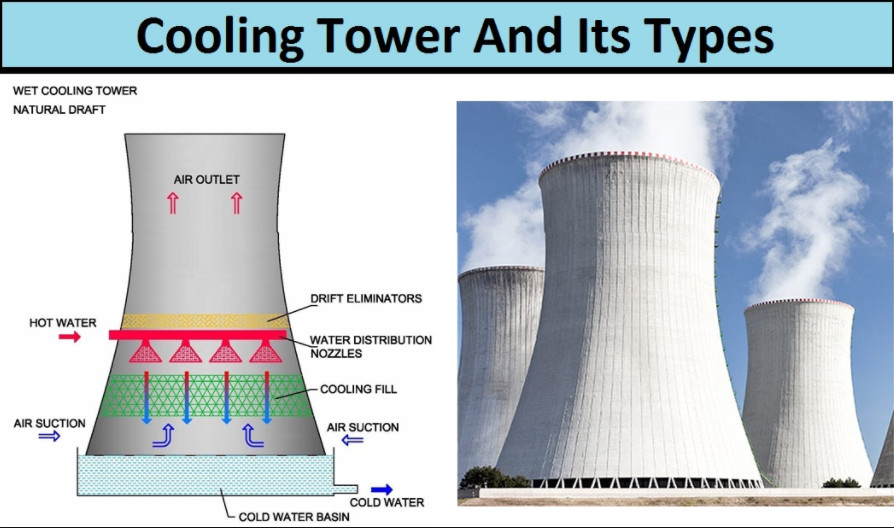 The closed cooling tower (also called the evaporative air cooler) places the tubular heat exchanger in the tower, and the cooling effect is ensured by the heat exchange between the circulating air, the spray water and the circulating water. Because it is a closed cycle, it can ensure the water quality is not polluted, which protects the efficient operation of the main equipment and improves the service life. When the outside temperature is low, the sprinkler system can be stopped to save water. Pushing the implementation of national energy conservation and emission reduction policies and the increasing shortage of water resources, in recent years, closed cooling towers have been widely used in steel metallurgy, power electronics, mechanical processing, air conditioning systems and other industries. In winter, the temperature in the northern part of the country is usually below zero, and the problem of anti-freezing of the closed cooling tower is becoming more and more prominent. If the solution is not good, the heat exchange tube or other components of the cooling tower may be frozen. According to different process characteristics, some of the closed cooling towers operate all day in winter, some of them run in part of the time, and some are almost unused. But all need to consider the antifreeze problem.
The closed cooling tower (also called the evaporative air cooler) places the tubular heat exchanger in the tower, and the cooling effect is ensured by the heat exchange between the circulating air, the spray water and the circulating water. Because it is a closed cycle, it can ensure the water quality is not polluted, which protects the efficient operation of the main equipment and improves the service life. When the outside temperature is low, the sprinkler system can be stopped to save water. Pushing the implementation of national energy conservation and emission reduction policies and the increasing shortage of water resources, in recent years, closed cooling towers have been widely used in steel metallurgy, power electronics, mechanical processing, air conditioning systems and other industries. In winter, the temperature in the northern part of the country is usually below zero, and the problem of anti-freezing of the closed cooling tower is becoming more and more prominent. If the solution is not good, the heat exchange tube or other components of the cooling tower may be frozen. According to different process characteristics, some of the closed cooling towers operate all day in winter, some of them run in part of the time, and some are almost unused. But all need to consider the antifreeze problem.
If the closed cooling tower does not need to be operated during the winter, the spray water and internal circulating water must be drained during shutdown.
Closed cooling tower, also known as closed cooling tower, evaporative cooler.
Five, no filler spray cooling tower
Product introduction: Low noise, energy saving, water saving, stable cooling effect and low maintenance.
1 Cooling tower development process
Due to the global natural resource characteristics of “lack of oil, less gas and more coal”, the energy supply mode based on thermal power generation will certainly remain unchanged for a long time. In addition, China is still a country with severe drought and water shortage. The total amount of fresh water resources is 2.77 trillion m3, ranking 6th in the world, but the per capita is only 2200m3, only 1/4 of the world average. It ranks 110th in the world and is the country with the least water resources in 13 countries. one. Therefore, except for some southern and coastal areas, DC cooling can be used. In most areas, thermal power plants use secondary circulation cooling with natural ventilation cooling towers, but in areas with water shortages in the north, more water-saving air cooling is adopted. When indirect air cooling is used, it is also necessary to construct a large natural ventilation indirect air tower.
China's cooling tower technology started late, but it has developed rapidly (Figure 1). In the late 1980s, China introduced the design technology of the Belgian Harmon Corporation (HAMON) cooling tower, and developed a computer-aided calculation and mapping program based on finite element analysis, which promoted the wide range of hyperbolic natural ventilation cooling towers in China. application.
Figure 1 Cooling tower height (m) with annual change chart Download original image
It is estimated that there are more than 1,000 cooling towers of various sizes in the country, most of which are conventional counterflow natural ventilation cooling towers. China's first natural ventilation cooling tower was built in Fushun Power Plant in 1936. The tower is 50m high and the watering area is 1000m2. With the construction of a large number of ultra-supercritical million-unit power plants in China, the application of super-large cooling towers (watering area exceeding 10,000 m2) has begun to appear gradually in China. The inundant area of the inland nuclear power plant under study will reach more than 18,000 m2 and the height will exceed 200 m. With the deep research and design of ultra-large cooling towers, it indicates that China's cooling tower technology has entered a new stage of development.
2 Application status of different cooling tower forms in China
2.1 Conventional wet cooling tower
Conventional wet cooling towers generally use fresh water as a cooling medium. After the high-temperature circulating water after heat exchange by the condenser is sprayed through the nozzle provided on the upper part of the water-filling filler, a water film is formed on the surface of the water-filling filler to exchange heat with the cold air. . The low-temperature water after heat exchange falls into the cooling tower pool, and the hot air after heat exchange is discharged into the atmosphere through the upper end of the cooling tower. The earliest super-large cooling tower put into operation in China is the conventional cooling tower of the 1000MW thermal power unit of Shandong Zouxian Power Plant. The cooling tower has a water shower area of 12000m2, a tower height of 165m, an air inlet height of 11.64m, and a throat diameter of 75.21m. 48 pairs of struts (Ф1.1m), the minimum wall thickness of the air cylinder is 220mm, and the ring plate type foundation.
2.2 Seawater Cooling Tower
The application of seawater circulating cooling water has been used for many years. Since the British company took the lead in adopting seawater cooling towers in the mid-1950s, more than 20 countries in the world have adopted seawater cooling towers, especially in the United States, Britain and France. Countries such as Germany and South Africa have already had more applications. With the improvement of environmental protection requirements, in order to reduce the impact of temperature and drainage of power plants on sensitive seawater, thermal power plants in some coastal areas of China have also adopted a secondary circulation cooling method with natural ventilation cooling towers. For example, the 2×1000MW unit of the second phase of Zhejiang Ninghai Power Plant and the 2×1000MW ultra-supercritical coal-fired generating unit of the first phase of Tianjin Beijiang Power Plant also adopted a seawater cooling tower.
2×1000MW units of the second phase of Zhejiang Ninghai Power Plant, each equipped with a 13000m2 seawater cooling tower. The main dimensions of the cooling tower are as follows: tower height 177.15m, inlet air inlet height 12.0m, tower bottom shell diameter 133.36m, throat diameter 77.94 m, 48 pairs of inclined pillars (Ф1.1m), the minimum wall thickness of the air cylinder is 0.22m, and the ring plate type foundation.
2.3 High water collection tower
The cooling tower with high water collection device was an energy-saving wet natural ventilation cooling tower designed by French Power Company and Belgian Harmon Cooling Tower Company in the late 1970s, and was built in France in the 1980s 1300MW nuclear power plant. Start applying.
At the beginning of 1990, China was designing a 2×330MW unit in the first phase of Shaanxi Pucheng Power Plant. It used two independently designed high-rise water-removing cooling towers with a watering area of 4,750 m2. The tower height was 131.48 m and the bottom diameter was 87.432 m. The height of the part is 95.323m, the diameter of the throat is 46.9m, and the diameter of the outlet is 51.834m.
The cost of the high water collection tower is about 22% higher than that of the conventional cooling tower, but the energy saving effect is obvious. The high water collecting tower is the only high water collecting tower built in China, and there are problems such as water leakage in the water receiving device and winter freezing, which has affected the further application of the high water collecting tower in China.
At present, the high-end water collection tower of Chongqing Wanzhou 1000 MW unit is currently being designed. It is designed by the domestic design institute and HAMON company. The preliminary design scheme has a water shower area of 13,000 m2, a total cooling tower height of 191.0 m and a bottom diameter of 140.3 m. The air inlet height is 13.8m.
2.4 Indirect air cooling tower
At present, air-cooling systems have been widely used in power plants in China's rich coal-deficient areas. Indirect air-cooling systems may become the first choice for the future due to their better safety and operational stability. The application prospects and market prospects are broad.
The large indirect air cooling tower that was first put into operation in China is the air cooling tower of Shanxi Yangcheng Power Plant. The tower height is 150m and the ring base diameter is 143m. Shanxi Shanyin Power Plant 2×300MW Unit 2 Unit One Tower Indirect Air Cooling Tower is 165m high and 160m in diameter. It is the largest cooling tower in China. The indirect air cooling tower of the 2×600MW unit of the first phase of Ningxia Shuidonggou Power Plant is 172m high and 145.5m in diameter. At present, the construction scale of domestic indirect air cooling towers has exceeded that of foreign countries.
2.5 smoke tower unity
The smoke tower integration plan is also widely used in China. Among them, Harbin No. 1 Thermal Power Plant, Tianjin Junliangcheng Power Plant and Hebei Sanhe Power Plant are the first power plants in China to adopt the smoke tower integration plan. Early application experience shows that the anti-corrosion problem of the tower cooling tower cooling scheme is more prominent.
the largest tower cooling tower in China is the cooling tower of 2×1000MW ultra-supercritical unit of Jiangsu Xuzhou Power Plant. The exhaust tower is the first million-unit exhaust smoke cooling tower in China. The exhaust tower of the exhaust cooling tower adopts a hyperbolic cast-in-place reinforced concrete structure with a tower height of 167.16m, a throat height of 129.68m, and an air inlet height of 11.70m. The inner diameter of the top surface is 80.688m, the inner diameter of the throat is 76.79m, and the inner diameter of the air inlet is 125.042m. The air cylinder shell is of equal thickness, the minimum thickness is 0.22m, the maximum thickness is 1.20m, and the cooling tower is made up of herringbone columns and rings. The plate foundation connection, the herringbone column and the ring plate foundation are cast-in-place reinforced concrete structures. The cooling tower body has a diameter of 10.50 m and a center elevation of 40.50 m. The FRP inner diameter of 8.50m FRP flue wall thickness is 31mm.
The expansion of Shaanxi Baoji No. 2 Power Plant (2×660MW) project uses the Heller-type indirect air cooling system. The indirect air cooling tower is the first “three-in-one” indirect air cooling tower in China. “Three in one” refers to: cooling, desulfurization, and platooning. The smoke uses the indirect air cooling tower, and the air cooling tower tower adopts hyperbolic reinforced concrete structure. The tower height is 170m, the outlet diameter is 84.466m, the inlet air level is 27.5m, the diameter is 125.664m, the throat height is 145m, the diameter is 82m, and the maximum wall thickness of the tube wall. 1.9m, the minimum thickness of the wall is 0.25m, the upper end of the tower is provided with a rigid ring, the outer side of the tower is distributed with 82 vertical long ribs, and the lower part of the wall is provided with 41 sets of "X" type pillars.
Shaanxi Qinling Power Plant adopts the table gaze indirect air cooling system, adopts “three-in-one” indirect air cooling tower, the air cooling tower is 179.81m high, the bottom diameter is 131.5m, the throat diameter is 8 3 m, the outlet diameter is 8 5 m, and the total concrete pouring reaches 15500m3, a total of 38 pairs of "X" pillar support with a vertical height of 27.8m, is the highest intercooling tower of the same type of units in Asia.
2.6 Mechanical Ventilation Cooling Tower
Mechanical ventilation cooling towers are used less in large thermal power plants, but are widely used in large gas turbine power plants. Inner Mongolia Baotou No. 2 Thermal Power Plant 2×200MW units, each unit is equipped with 6 counterflow type mechanical ventilation cooling towers, each with a cooling water volume of 4200m3/h and a fan power of 160kW. The two towers of the 2×200MW unit are arranged in parallel, and the net distance of the tower group is 20m.
Beijing Sun Palace Gas Thermal Power Cooling Power Supply Plant is located in the urban area of Beijing. It is a supporting construction project for the Beijing 2008 Olympic Games. It will build a 780MW “two tow one” gas-fired combined cycle unit with nine 18×18×24m mechanical ventilation cooling towers. , a word layout. In order to reduce the noise impact on neighboring residential areas, single-sided air intake is adopted, and noise reduction measures and landscaping are set.
3 Research status of cooling tower design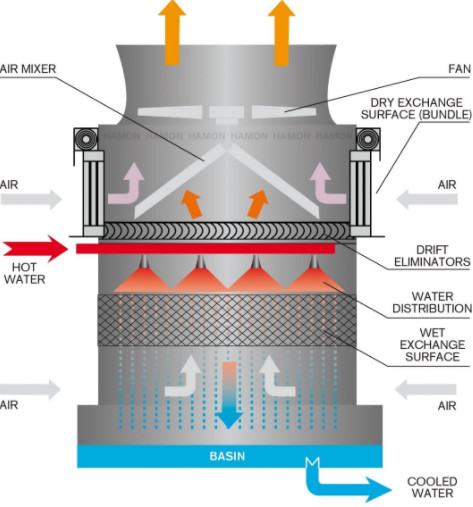 There are more than 20 thermal power design units in China, and the design unit has more than 600MW unit design qualification and engineering experience. There are about hundreds of engineers working on cooling tower design in the country, with a good educational background, rich engineering experience and perfect software and hardware facilities. There are also many research institutes and universities in China that have deep research capabilities in cooling towers, such as Beijing Institute of Water Resources and Hydropower Research, Peking University and Zhejiang University.
There are more than 20 thermal power design units in China, and the design unit has more than 600MW unit design qualification and engineering experience. There are about hundreds of engineers working on cooling tower design in the country, with a good educational background, rich engineering experience and perfect software and hardware facilities. There are also many research institutes and universities in China that have deep research capabilities in cooling towers, such as Beijing Institute of Water Resources and Hydropower Research, Peking University and Zhejiang University.
In recent years, in response to the needs of large-scale thermal power plants and inland nuclear power construction, a number of design units and domestic scientific research institutions have carried out a series of experimental studies on large-scale cooling towers, smoke towers, seawater cooling towers, etc., including large-scale wind tunnel experiments. Cooling tower wind load measurement, cooling tower group effect analysis, large-scale cooling tower finite element dynamic and static analysis, three-dimensional finite element structural analysis, different finite element software comparative analysis, multi-country standard comparative analysis, cooling tower collapse research, multi-dimensional finite element thermal analysis Optimization, etc., accumulated a large amount of research data, providing a certain basic support for the design and construction of large cooling towers. At the same time, the joint design of large-scale cooling towers based on actual engineering projects by various design units has also been carried out to a considerable depth. For example, the Hunan Taohuajiang Nuclear Power Tower, which was researched by East China Design Institute and GEA, is 200m high, and the preliminary design plan has been completed; HAMON Company Participated in the design of the Hubei Xianning Nuclear Power Tower and the design of the large tower of Jiangxi Pengze Nuclear Power Plant. In addition, the China Energy Construction and Construction Group has also established a special large-scale cooling tower research center.
The domestic design institute can complete the general cooling tower design work according to the existing specifications and the self-developed perfect cooling tower thermal calculation and structural finite element calculation software. At the same time, many design institutes and research institutions use FLUENT software or other finite element programs. Two-dimensional and three-dimensional simulation calculations are carried out on the thermal performance of the cooling tower to ensure that the design conditions and operational safety are met. The general finite element programs ANSYS, SAP, ASTRAN and ABAQUSD are used to simultaneously perform mechanical analysis and comparison to ensure the structure satisfied by the cooling tower. Safety. The joint design process with famous foreign cooling tower design companies such as HAMON and GEA also shows that the domestic design capability is at the same level as international companies.
4 Challenges
4.1 Large capacity units need to build larger cooling towers
China's power industry has developed rapidly. In the past 10 years, the annual average power generation capacity of the power industry has increased by 11%. The thermal power unit has shown a trend toward high parameters, large capacity and low emissions. At present, the single unit capacity has reached 1000 MW, and the super 1000 MW unit is also under study. . Inland 1000MW nuclear power units and 1000MW indirect air cooling systems for thermal power plants in the northern water-deficient coal-rich areas are also under study. The construction of large-capacity thermal power units and inland nuclear power has placed an urgent need on the design and construction of large-scale cooling towers.
With the large-scale and diversified cooling towers, higher requirements have been placed on the safety of cooling towers. The safety of a cooling tower involves two aspects: First, operational safety. The design and construction of the cooling tower should meet the requirements of safe and economic operation of the power plant and meet the cooling performance requirements under different design conditions. The second is the security of the structure. As a large-volume thin-walled shell structure, the cooling tower has a significant structural safety problem under different loads and throughout the design life cycle. As the cooling tower height and diameter increase, how to ensure the overall and local cooling tower The structural safety is becoming more and more important and requires more in-depth research. At the same time, it is also an important task for engineers to reduce the project cost as much as possible while satisfying safety.
4.2 Cooling tower design should pay more attention to environmental protection
The rapid development of China's economy is also paying a serious environmental cost. The severe smog weather that has appeared many times in many places in the country is a good example. As a large coal-fired enterprise, thermal power plants have also become the target of public criticism. The state has put forward higher environmental protection requirements for the construction of thermal power plants, synchronized the construction of desulfurization and denitrification facilities, and conducted research on mercury removal, and it is forbidden to ban new thermal power plants in some densely populated developed areas. Therefore, the construction of the cooling tower should also meet the higher environmental protection requirements. In some urban areas, it is required to reduce or eliminate the cooling tower fog, dripping and beautifying the cooling tower body to reduce the impact on the urban landscape; Or noise impact in the plant, setting noise reduction measures or adopting a low noise cooling tower scheme; in order to save fresh water resources and reduce marine thermal pollution, seawater cooling towers are required; for power plant projects with limited land area, chimney height limit or other conditions A plan to use a smoke evacuation tower is required.
4.3 Cooling tower design should pay more attention to energy saving
In order to significantly reduce energy consumption, the state has put forward strict energy-saving standards for project construction. At the same time, rising basic energy prices, such as coal prices, have also promoted the promotion of energy-saving technologies and design concepts. As a thermal power unit, the lower cooling water temperature can reduce the unit operating back pressure, while the lower unit back pressure can reduce the unit coal consumption, thus achieving energy saving. However, the lower cooling water temperature poses a challenge to the design of the cooling tower. One is to increase the area of the cooling tower; the second is a more efficient water-filling filler; the third is a more uniform air distribution system; the fourth is to reduce the process. Hydraulic loss, such as the use of high water collection tower; fifth is to improve the use of preheating.
The main function of the cooling tower is cooling. In the wet cooling tower and the air cooling tower, the core material and the radiator are the key products to ensure the cooling effect. China's wet-cold tower core material was absorbed and digested with the introduction of HAMON cooling tower technology in the 1980s and 1990s. There has been a period of product development and improvement climax, but in the past decade, there have been few high-efficiency new products, air-cooled radiators. Insufficient new product research and development capabilities and slow product updates have become a weak link in the continued development of domestic cooling tower technology. Therefore, tracking foreign advanced product information and strengthening new product development will become a must.
4.4 Backward standards restrict the design of the cooling tower.
Although many cooling towers with a watering area of over 10,000 m2 have been built in China, there is no consensus on the design of large cooling towers above 200 m. In recent years, many domestic design and research units have carried out various research work. For example, China Energy Construction Group has also formulated the “Ultra Large Cooling Tower Design Guidelines”, “Fume Cooling Tower Design Guidelines” and “Seawater Cooling”. Tower Design Guidelines, etc., to a large extent make up for this deficiency. The state has also developed some design technical standards and specifications for cooling towers, but it is still relatively backward in the relevant cooling tower standards, and the update speed cannot be satisfied.
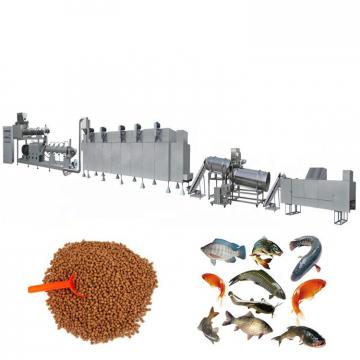 Animal Aquarium Pet Dog Cat Monkey Fox Bird Tilapia Floating Fish Feed Pellet Production Machine Snack Food Mill Processing Making Extrusion Line for Sale
Animal Aquarium Pet Dog Cat Monkey Fox Bird Tilapia Floating Fish Feed Pellet Production Machine Snack Food Mill Processing Making Extrusion Line for Sale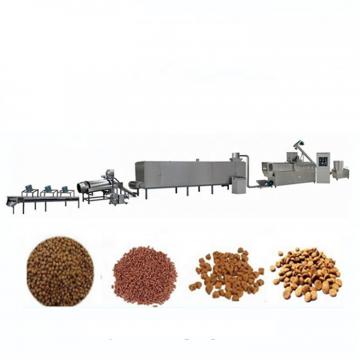 Animal Aquarium Pet Dog Cat Monkey Fox Bird Tilapia Floating Fish Feed Pellet Production Machine Snack Food Mill Processing Making Extrusion Line for Sale
Animal Aquarium Pet Dog Cat Monkey Fox Bird Tilapia Floating Fish Feed Pellet Production Machine Snack Food Mill Processing Making Extrusion Line for Sale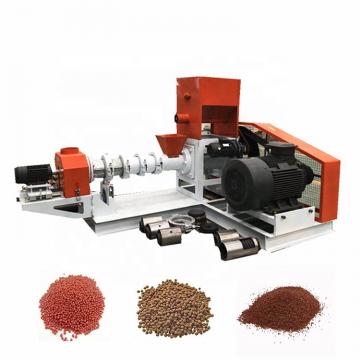 Various Shapes Fish Food Processing Line /Pet Food Production Line
Various Shapes Fish Food Processing Line /Pet Food Production Line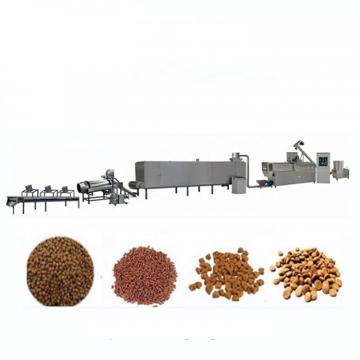 China Manufacturer Pet Food Fish Feed Processing Line
China Manufacturer Pet Food Fish Feed Processing Line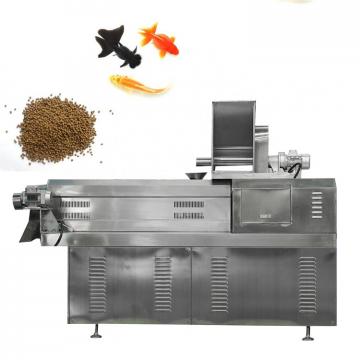 Animal Aquarium Pet Dog Cat Bird Tilapia Floating Fish Feed Pellet Production Machine Snack Food Mill Processing Making Extrusion Line Price
Animal Aquarium Pet Dog Cat Bird Tilapia Floating Fish Feed Pellet Production Machine Snack Food Mill Processing Making Extrusion Line Price
Oil Mill Machinery China Manufacturer cold press oil machine soy protein production line Auxiliary Machine For Oil Press Continous Single Layer Mesh Belt Dryer Conveyor Dryer Hot air drying oven Fruit and vegetable drying machine Micro Wave Oven fastfood microwave fast heating equipment Multi-layer Oven Bread Crouton chips line Sweet potato starch machine twin screw extruder Stretch Film Machine Rolls Starch modified machine floating fish feed extruder machine Artificial rice extrusion line Frying Instant Noodles machine Japanese Peanut Equipment starch machine Nutritional Powder extrusion line Microwave drying machine TOFU PRODUCTION LINE Single screw extruder Pop cereals grains machine snack pellet production line Potato chips production line Chocolate Bar Machine 123
